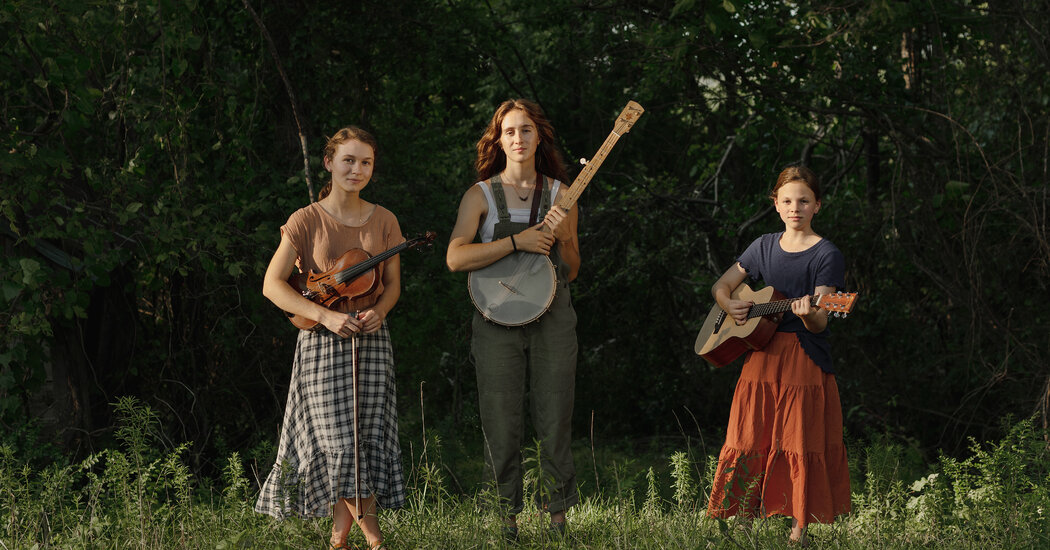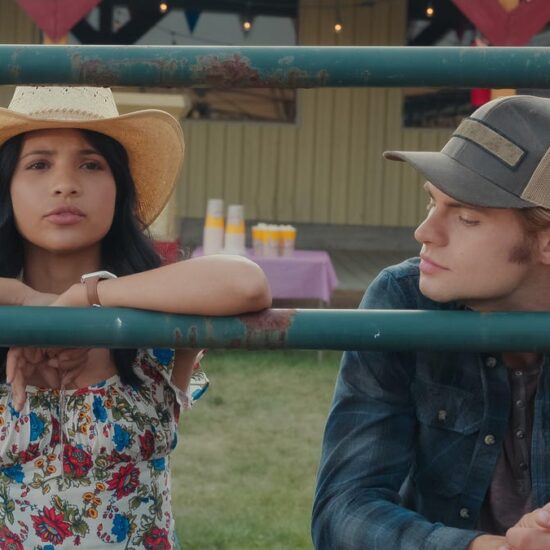
A merciful evening breeze kicked up, swatting away the Arkansas heat and giving wing to the melodies coming from two of the gazebos in the grassy park. In the larger one, a dozen people were playing the last strains of “Barbry Allen” on fiddles, mandolins, guitars, a stand-up bass, dulcimers, banjos and even a dulci-banjo.
A pretty tune I did not recognize drew me over to the smaller group. But I never got to ask what it was because, just as I approached, they stopped. Then their fiddler lowered his instrument and, in a clear, bold bass, started singing “I’ve Been Everywhere” — all of it, even the often neglected opening verse that name-checks Winnemucca. With the others playing along, he gave a performance Johnny Cash would have admired, no stumbles or stutters and not a single -burg, -ville or -ton forgotten.
I did wonder, though, why he hadn’t thrown in “Mountain View” — the town we were in that evening — not only because it would have fit so nicely with “Baraboo, Waterloo, Kalamazoo,” but also because I suspected that he, like me and a lot of other people in that park, had gone to some effort to get there.
Crafts and characters
All the roads to Mountain View, the seat of Stone County, in the Ozarks of northern Arkansas, are two-lane and twist through towns with names like Pumpkin Bend, Grubbs, Fifty-Six and Oil Trough. The last of these, a settlement beside the White River, traces its appellation back to the early 19th century, when hunters and trappers there used hollowed logs to render bear fat into lamp and cooking oil.
Those roads are all paved now, though that wasn’t the case until the 1970s. Mountain View wasn’t electrified until the 1930s, and didn’t get much radio until after World War II. Even decades later, it still lacked certain basic amenities — an absence that eventually played a part in the creation of the attraction that today brings many people to Mountain View for the first time: Ozark Folk Center State Park.
It’s not exactly on the way to anywhere. “You have to really want to come here,” Keith Symanowitz, the park’s promotions director, said. Even so, some 90,000 people do every year.
The center, which turned 50 this year, is singular among Arkansas’s 52 state parks in that its draw is not landscape and nature. “Our resource here is the people,” Mr. Symanowitz explained. “Our mission here is to perpetuate, present and promote the Ozark way of life.”
They do so by giving the people of the region, which is rural and largely white, a place to do the things they’ve always done — and where folks “from off,” as they say there, can watch them do it and even try it themselves: making quilts, brooms, knives and home remedies; carving wood, forging iron, tanning and shaping leather; weaving and dyeing fabric. One woman makes dolls from dried corn shucks — exactly, she told me, as her mother did, and her grandmother before that. “Play with your garbage!” she called out as I left her shop.
No one is in costume or character; while some craftspeople come from off, many, like that doll maker, are locals who are just doing at the park what they would be doing at home.
“There was great isolation, really, for ever so long” in the area, explained Kay Thomas. Everyone learned to make “stuff that you had to have for everyday existence.” Ms. Thomas, who is retired now, came from off (in her case, Little Rock) just out of high school and started working at the folk center when it opened.
It’s not uncommon to meet people who have been at the park that long or almost. A woman who worked at its gift shop until last spring grew up in a log cabin built by her father — no electricity or running water. That cabin, which the family abandoned in 1963, was later moved to the park and is now an exhibit there.
‘We’re not Branson’
For people who hear “Ozarks” and think of the bright lights, capacious venues and folksy kitsch of Branson, Mo., 110 or so miles northwest, this is very different. By design. “There has always been a consciousness around the folk center: We’re not Branson,” Charley Sandage, who helped get the center going, explained.
The Ozarks straddle the Arkansas-Missouri border, but the Missouri part has more industry, is more densely populated and draws more visitors. Historically, Mr. Sandage said, “Missourians thought they were better than Arkansas people.”
Like underdogs everywhere, people in the Arkansas Ozarks made that status a point of pride. They also had the confidence to go their own way. If just the Ozark region had voted before the Civil War, Mr. Sandage said, secession “never would have happened.”
Back in the early 1960s, Mr. Sandage explained, Stone County “was statistically among the poorest counties in the United States.” The town desperately needed a water and sewer system, but couldn’t afford one. People started to wonder if Mountain View might be able to attract federal grants using, as Mr. Sandage put it, its “deep pool” of Ozark culture, which abided long after other such pools had dried up almost everywhere else.
The folk center was open within a decade. Today, in addition to local craftspeople and musicians, it features extensive gardens growing many heritage plants that Ozark people have made use of for generations, like jewel weed, whose juice can soothe chigger bites, and elderberry, which when distilled into a tincture is said to break fevers. And the park has a thousand-seat theater, which hosts shows, traveling acts, weekly square dances and “Ozark Highlands Radio,” a variety program that airs on more than 100 stations nationwide.
Time to make music
Mountain View got its water and sewer systems, but aside from that, and the fact that you can get at least some cellphone service in town, it seems not much else has changed there since the ’60s. Once after supper, walking down Main Street, I met a young woman who greeted me with, “And how are you this fine evening?” A block down, I looked through the plate-glass window of the town community center and saw a crowd gathering; a woman inside, spotting me, came to the door and invited me in. “This is our monthly meet-up,” she explained. “We’ll be talking about greenhouses.”
Though Mountain View’s economy depends to a large extent on tourism, the place is — and this may be hard for someone from off to accept at first — utterly authentic. People there are just living their lives as they always have, not because they think you will find it enchanting, but because that is what they do and they like doing it. They are quite happy to have you there, but no one will fawn over you or do anything other than what they would be doing anyway.
And what a great many of them are doing is making music together.
Three nights a week, a modest space called the Mountain View Meeting Place becomes Club Possum, which hosts local musicians and bands and livestreams them on YouTube and Facebook. The shows last two hours, and admission is free. The audience is a mix of local and from off, and while there’s no bar — Stone County is dry, a fact many residents credit with preserving the town’s character — you can buy a bag of popcorn for $1.
Walk around town almost any evening when the weather is amenable and you will see and hear musicians playing. Once I came upon four women — two banjos, two mountain dulcimers — jamming on the side porch of a shop called Mountain View Music. One of them explained that the tune they’d just played, “Santa Anna’s Retreat,” had Celtic undertones because the Mexican general the song was named for had Irish mercenaries in his ranks.
The folk center is among the largest employers in the area, and many of the musicians you’ll encounter in the evenings have day jobs at the park, including two of the women in that ensemble. One of the banjo players, who is potter there, told me at her shop the next day that she also played with a different group on Saturdays: “I could do that, or I could stay at home and watch TV.”
They play on porches, on lawns, at inns and around the courthouse, but most often they play at a green space on Washington Street that people call the pickin’ park, sandwiched between a trailer that sells ice cream and a pink, Victorian bed-and-breakfast. You can sometimes find people playing there in the heat of day, but as the light wanes, many more come out to make music in one of the park’s three gazebos.
I’ve watched gatherings as small as two and as large as 15 jam together, individuals dropping in when they get off work or out when they go home to bed. They play bluegrass, folk, classic country and gospel. But the music you will hear most often is old-time string band: tunes and ballads that traveled across the Atlantic on wooden ships in the 18th and 19th centuries. These are people whose ancestors settled in the Ozarks not long after the Louisiana Purchase, but also people from off who come with their instruments just to do this. Some have known each other for decades, even their whole lives. Others have never met before.
They have, it seems, a few unspoken rules: They don’t use written music or electric speakers, and they never, ever pass the hat or open an instrument case, toss in a few seed dollars and hope you’ll follow their example. “If someone offered a tip, they’d probably get their hand bit,” Mr. Sandage, who plays guitar, explained.
Treasure for the ears
There are other things that entice people from off to motor up those slender winding roads to Stone County, like Blanchard Springs Caverns, a subterranean wonderland on National Forest land that’s also celebrating its 50th anniversary. And it’s tempting to conjure some metaphor about Mountain View being an underground treasure like those caves. But it’s not. Its luster is right out in the open, at the folk center and the pickin’ park, on patches of grass all over town and on porches, like the one at Mountain View Music.
“Just in our front yard alone, there may be a group on that little end porch, another group here right outside the front door, another group out there on the little pickin’ pad,” said Scott Pool, who owns the store with his wife, Shay. By day, they sell, buy and repair instruments, and make them to order, but after they close up, their building becomes a community hub. Elsewhere, that might be odd. Here, it’s emblematic.
“Branson is a fun place to go; it’s got a lot of attractions, a lot of theaters,” Mr. Pool mused. “But if you took away the tourists in Branson, there’d be nothing left. Here, if you took away all the tourists, it would hurt us all economically, but people would still be playing music on the square, because it’s for the love of the music. It’s just what they do.”
To hear more about Mountain View and Ozark culture, check out the New York Times Audio app.
Follow New York Times Travel on Instagram and sign up for our weekly Travel Dispatch newsletter to get expert tips on traveling smarter and inspiration for your next vacation. Dreaming up a future getaway or just armchair traveling? Check out our 52 Places to Go in 2023.













